ಮಿಂಗ್ ಮಿಂಗ್ ನ ಟೊಂಯ್ ಟೊಂಯ್ ಮತ್ತು ನಗುವಿನ ಗುಟ್ಟು
Posted by Remya Padmadas on December 02, 2019Pratham Books' in-house editor, Hema D Khurshapur, writes exclusively about translations and how they end up giving the feel of the original story, if given a fresh approach. In this blog post, she writes about C.P. Ravikumar's translation of Ming-Ming, Fat Little Bear’s translation into Kannada and the psychology behind laughter.
ಮನುಷ್ಯರ ಮಕ್ಕಳಿಗಷ್ಟೇ ತುಂಟತನ ಸೀಮಿತವೇ? ಪ್ರಾಣಿಗಳ ಮಕ್ಕಳೂ ತುಂಟತನ ಮಾಡಬಹುದಲ್ಲವೇ? ಅದ ರಲ್ಲೂ ಮುದ್ದಿಗೆ ಹೆಸರಾದ ಕರಡಿ ಮರಿಗಳು ತುಂಟತನ ಮಾಡಿದರೆ ಹೇಗಿರುತ್ತದೆ. ಅದೇ ಈ ಪದ್ಯದಲ್ಲಿ ಮೂಡಿ ಬಂದಿರುವುದು. ಕೂದಲಿಗೆ ಉದಾಹರಣೆ ಕೊಡುವಾಗ ನಾವೆಲ್ಲ ಒಂದಲ್ಲ ಒಂದು ಸಲ ಬಳಸಿರುವ ವಾಕ್ಯ, ಅಲ್ಲಿ ನೋಡು ಅವನ ಅಥವಾ ಅವಳ ಕೂದಲು ಕರಡಿ ಕೂದಲಂತೆ ಎನ್ನುವುದು.
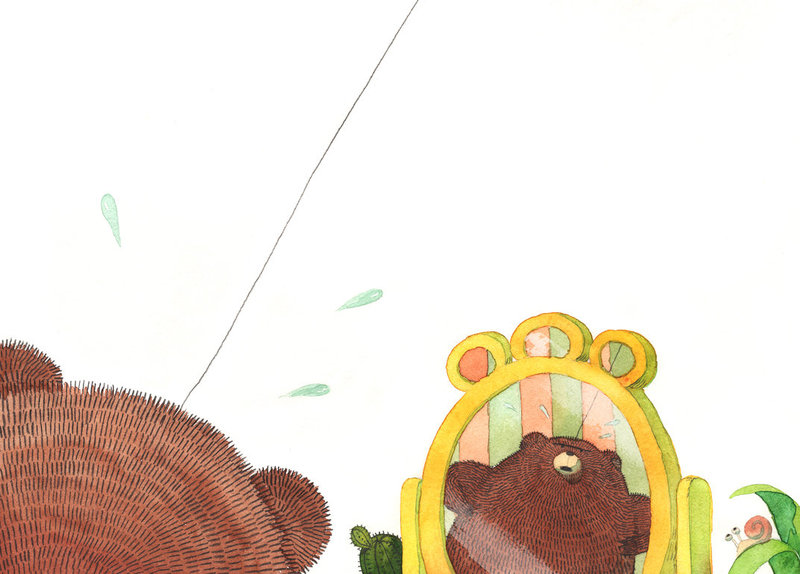
Illustrations from the book, Ming-Ming, Fat Little Bear, by Vishnu M Nair
ಕನ್ನಡದಲ್ಲಿ ಕರಡಿ ಮತ್ತು ಕರಡಿ ಮರಿ ಕುರಿತಾಗಿ ಬಹುತೇಕ ಮಕ್ಕಳು ಕೇಳಿರಬಹುದಾದ ಒಂದು ಕವನ, ಒಂದು ಕತೆ ಇದೆ. ಕವನ ಅಂದ್ರೆ ಅದು ಬೇಂದ್ರೆಯವರ ‘ಕರಡಿ ಕುಣಿತ’, ಕತೆ ‘ಜಾಂಬವಂತ’ ಕರಡಿಯ ಕತೆ. ‘ಕರಡಿ ಕುಣಿತ’ ಕವನ ಕರಡಿ ಆಡಿಸುವವನಿಂದ ಶುರುವಾಗಿ, ಮಕ್ಕಳು ಕರಡಿಯನ್ನು ಮುಟ್ಟಿ ನೋಡುವ ಪ್ರಕ್ರಿಯೆ ಮುಗಿದು, ಕರಡಿಯ ಕೂದೆಲೆಳೆ ಮಕ್ಕಳಿಗೆ ದೃಷ್ಟಿಯಾಗದಂತೆ ತಡೆಯುತ್ತದೆ ಎನ್ನುವ ನಂಬಿಕಯೊಂದಿಗೆ ಮುಗಿಯುತ್ತದೆ. ‘ಜಾಂಬವಂತ’ ಕರಡಿಯ ಕತೆಯಲ್ಲಿ ಬರುವ ಕರಡಿ ಮಾತ್ರ ಜೇನು, ಹಲಸಿನ ಹಣ್ಣು ತಿನ್ನುವ ಮುದ್ದು, ಮುದ್ದು ಪ್ರಾಣಿಯಾಗಿ ಮಕ್ಕಳನ್ನು ಸೆಳೆಯುತ್ತದೆ.
ಆದರೆ ಈ ಮಿಂಗ್ ಮಿಂಗ್ ಎಂಬ ಕರಡಿ ಮರಿ, ಇನ್ನೂ ಮುದ್ದು ಮುದ್ದು. ಒಂದು ದಿನ ಬೆಳಗಾಗಿ ಎದ್ದು ನೋಡಿದರೆ ಮರಿಯ ತಲೆಯ, ಮೈಮೇಲಿನ ಕೂದಲೆಲ್ಲ ನೆಟ್ಟಗೆ ನಿಂತಿವೆ. ಅದಕ್ಕೆ ಏನು ಮಾಡಬೇಕೋ ತೋಚುತ್ತಿಲ್ಲ. ಯಥಾ ಪ್ರಕಾರ ಅಪ್ಪ-ಅಮ್ಮ, ಅಣ್ಣ-ಅಕ್ಕ, ದೊಡ್ಡಪ್ಪ-ಚಿಕ್ಕಪ್ಪ ಎಲ್ಲರೂ ಒಂದೊಂದು ಸಲಹೆ ಕೊಡುವವರೇ. ಎಲ್ಲರ ಮಾತು ಕೇಳಿ ತಲೆ ಚಿಟ್ಟು ಹಿಡಿದು ಮಲಗುವ ಕರಡಿ ಮರಿಯ ಕೂದಲು ಮತ್ತೊಂದು ಬೆಳಗ್ಗೆ ಎದ್ದು ನೋಡುತ್ತಲೇ ಮೊದಲಿನಂತಾಗಿ ಬಿಟ್ಟಿರುತ್ತದೆ.
ಇಂಗ್ಲಿಷ್ ನಲ್ಲಿ ಎಲ್ಲವೂ ಸರಿ ಎನ್ನಿಸಿಯೇಬಹುದಾದ ಅಥವಾ ಹಾಗೆಂದು ನಾವು ಭಾವಿಸುವ ವಾಕ್ಯ ರಚನೆಗಳನ್ನು ಕನ್ನಡಕ್ಕೆ ತರುವಾಗ ಎದುರಾಗುವ ಸಮಸ್ಯೆಗಳು ಒಂದೆರಡೆಲ್ಲ. ಅದು ಅನುವಾದ ಪ್ರಕ್ರಿಯೆಯಲ್ಲಿ ತೊಡಗಿ ಕೊಂಡವರಿಗೆಲ್ಲ ಗೊತ್ತಿರುವ ವಿಷಯ. ಈ ಕವನವನ್ನು ಕೂಡ ಇಂಗ್ಲಿಷಿನಲ್ಲಿ ಓದುವಾಗ ಚೆಂದ ಎನಿಸುವ ಪ್ರಾಸಗಳನ್ನು ಕನ್ನಡಕ್ಕೆ ತರುವುದು ನಿಜಕ್ಕೂ ಸ್ವಲ್ಪ ಕಷ್ಟದ ಕೆಲಸ. ಕವನ ವನ್ನು ಟ್ರಾನ್ಸ್ ಫಾರ್ಮ್ ಮಾಡದೇ ಅನುವಾದದಲ್ಲಿ ಸ್ವಲ್ಪ ಮಟ್ಟಿನ ಸ್ವಾತಂತ್ರ್ಯ ವಹಿಸಿ ಒಂದೆರೆಡು ವಾಕ್ಯ, ಒಂದೆರೆಡು ಸಾಲುಗಳನ್ನು ಸೇರಿಸುವ ಮೂಲಕ ಕವನವನ್ನ ಕನ್ನಡದ್ದೇ ಆಗಿಸಿದ್ದು ಅನುವಾದದ ಮಟ್ಟಿಗೆ ಒಳ್ಳೆಯ ಪ್ರಯತ್ನ. ಓದುತ್ತಿದ್ದರೆ ನಗುವನ್ನು ತಡೆಯಲು ಆಗದ ಕೆಲಸ. ಇಂತಹ ಒಳ್ಳೆ ಪ್ರಯತ್ನಕ್ಕಾಗಿ ಅನುವಾದಕ ಸಿ.ಪಿ.ರವಿಕುಮಾರ್ ಅವರಿಗೆ ಅಭಿನಂದನೆಗಳು.
ಬರೀ ಮಿಂಗ್ ಮಿಂಗ್ ಎಂಬ ಮುದ್ದು ಕರಡಿ ಮರಿ ಪದ್ಯ ಕನ್ನಡಕ್ಕೆ ಅನುವಾದಗೊಂಡ ಪ್ರಕ್ರಿಯೆ ಚೆಂದವಾದದ್ದು ಅಂತ ಓದಿದರೆ ಸಾಕೇ... ಓದುವಾಗ ಬರುವ ನಗು, ಹುಟ್ಟುವುದು ಹೇಗೆ ಎನ್ನುವುದರ ಬಗ್ಗೆಯೂ ಒಂದು ಕುತೂಹಲವಾದ ವಿಷಯವಿದೆ.
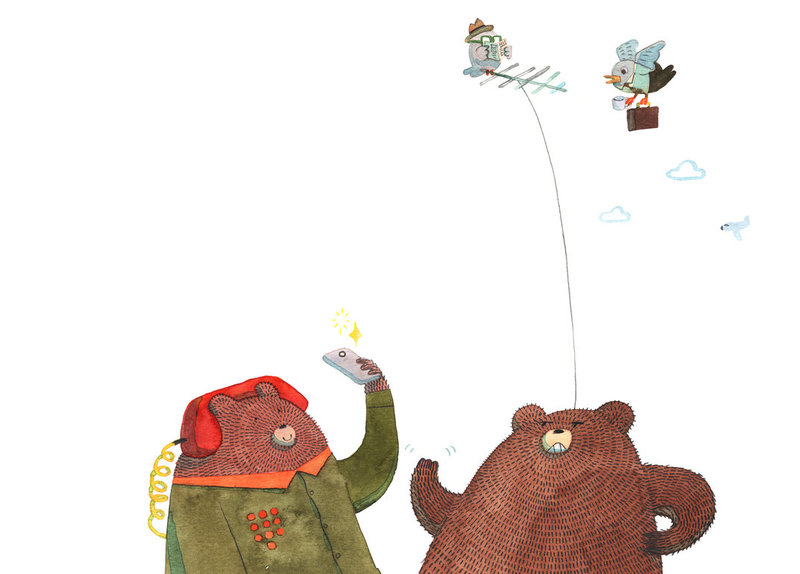
Illustrations from the book, Ming-Ming, Fat Little Bear, by Vishnu M Nair
ನಗು ಹುಟ್ಟುವುದು ಹೇಗೆ?
ಪ್ರಶ್ನೆಗೆ ಉತ್ತರ ತುಂಬಾ ಸರಳ. ಒಬ್ಬ ಹಾಸ್ಯನಟನನ್ನು ನೋಡಿದರೆ ಸಾಕು, ನಮಗೆ ತಿಳಿಯುತ್ತದೆ! ಆದರೆ ನಗೆ ಸಂಕೀರ್ಣ ವಿಷಯ. ನಾವು ಸಹಜವಾಗಿ ಭಾವನೆಗಳನ್ನು ಅಭಿವ್ಯಕ್ತಿಸುತ್ತೇವೆ. ನಗು ಮನುಷ್ಯರ ನಡುವೆ ಮಾತ್ರ ಕಂಡು ಬರುತ್ತದೆ. ಆದರೆ, ಮನಃಶಾಸ್ತ್ರಜ್ಞರು ನಗುವಿನ ಬಗ್ಗೆ ಎರಡು ಮೂಲಭೂತ ಪ್ರಶ್ನೆಗಳನ್ನು ಇನ್ನೂ ಅಧ್ಯಯನ ಮಾಡುತ್ತಿದ್ದಾರೆ. ಒಂದು, ಜನರನ್ನು ನಗುವಂತೆ ಮಾಡುವುದು ಯಾವುದು? ಎರಡು, ನಗುವಿನ ಉದ್ದೇಶವೇನು? ಜನರು ನಗುವಂತೆ ಮಾಡುವ ಅಂಶ ಯಾವುದು ಅಥವಾ ಜನ ಯಾವುದನ್ನು ತಮಾಷೆ ಎಂದು ಪರಿಗಣಿಸುತ್ತಾರೆ ಎಂದು. ಉತ್ತರ ಹುಡುಕುತ್ತಾ, ಆಲೋಚಿಸುತ್ತಾ ಹೋದರೆ ನಾವು ಮನಃಶಾಸ್ತ್ರಜ್ಞ ಅಥವಾ ತತ್ವಜ್ಞಾನಿಗಳಾಗಿ ಬಿಡುತ್ತೇವೋ ಏನೋ?
ಜನರ ಕೆಲವು ಎಡವಟ್ಟು, ವ್ಯಕ್ತಿಯ ದೌರ್ಬಲ್ಯ ಅಥವಾ ಕುಂದು-ಕೊರತೆ, ಕಾಳಜಿಯ ಸಂದರ್ಭಗಳಲ್ಲೂ ಜನರು ನಗುತ್ತಾರೆ. ನಗುವಿನ ಬಗೆಗಿನ ಮತ್ತೊಂದು ವಿವರಣೆ ಎಂದರೆ, ಇದ್ದಕ್ಕಿದ್ದಂತೆ ನೋಡಿದ ಕೆಲವು ದೃಶ್ಯಗಳು ನಗು ಹುಟ್ಟಿಸುತ್ತವೆ. ಅವು ಸಹಜ ಸಂಗತಿಗಳೇ ಇರಬಹುದು ಅಥವಾ ವ್ಯಕ್ತಿಗಳು ಜತೆಗಿದ್ದಾಗ ಕಣ್ಣ ಮುಂದೆ ನಡೆಯುವ ವಿಷಯಗಳಿರಬಹುದು. ಎಲ್ಲ ರೀತಿಯ ನಗುವಿಗೂ ಈ ಸಿದ್ಧಾಂತ ಅನ್ವಯವಾಗುವುದಿಲ್ಲ. ಕಾಮಿಕ್ ನೋಡಿದಾಗ ಉಕ್ಕುವ ನಗುವೇ ಬೇರೆ, ವಿನೋದ ಸಾಹಿತ್ಯ ಅಥವಾ ಘಟನೆ ನೋಡಿದಾಗ ಉಂಟಾಗುವ ನಗುವೇ ಬೇರೆ. ದೈಹಿಕವಾಗಿ ನಗುವಿನ ಅಂಶವನ್ನು ನೋಡಿದರೆ, ನಗು ಒಳ್ಳೆಯದು. ಇದು ನಮ್ಮ ಶ್ವಾಸಕೋಶಕ್ಕೆ ಮತ್ತು ದೇಹಕ್ಕೆ ಬೇಕಾದ ಹೆಚ್ಚುವರಿ ಶಕ್ತಿಯನ್ನು ಒದಗಿಸುತ್ತದೆ. ನಾವು ಸಾಮಾನ್ಯವಾಗಿ ಹೆಚ್ಚು ನಗುವುದು ಒಂದು ಗುಂಪಿನಲ್ಲಿದ್ದಾಗ. ಈ ಸಿದ್ಧಾಂತದ ಪ್ರಕಾರ ಜನರ ನಗುವನ್ನು ನೋಡಿ ಅವರ ವರ್ತನೆಯ ಟಿಪ್ಪಣಿ ಮಾಡಬಹುದಂತೆ!!
Do leave your thoughts in the comments section below. You can also reach out to us through our social media channels: Facebook, Twitter and Instagram.
Be the first to comment.How to make your StoryWeaver profile shine!
Posted by Sangeeta Velegar on April 19, 20181. Put a face to that name!
Click on your name on the top right of the menu. Select "Dashboard" from the drop-down. You should see "My Details" - everything you'd like your audience to know about you! First off, upload a picture of yourself!
2. Tell us a little bit about yourself, will you?
See that field marked "Profile Description"? Fill the box with a short description of yourself. Things you like. Stuff you loathe. You get the drift.
3. Where do you live on the web?
Have a website? A portfolio? A social media footprint that will help people know more about your creative accomplishments? Just fill in the address in the box labelled "Website."
Just one last thing - hit "Submit," and your brilliant, updated profile goes live. Enjoy!
Take a look at author Roopa Pai's profile page below for some inspiration!
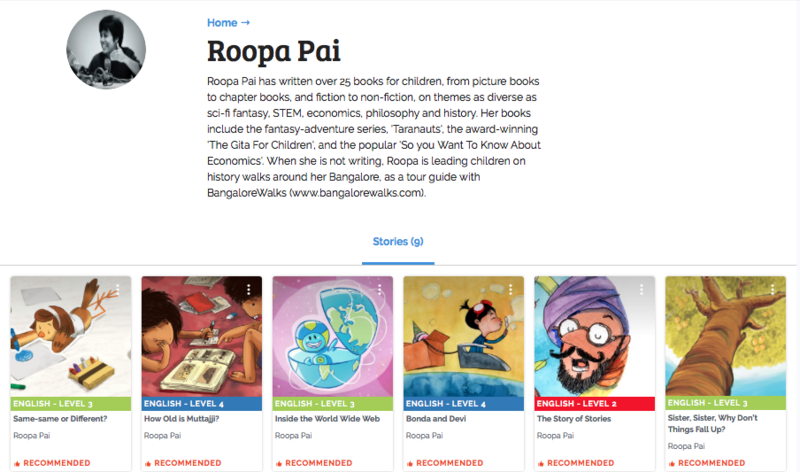
Be the first to comment.
StoryWeaver Selected as Finalist for the WISE Awards 2018
Posted by Maya H on April 10, 2018We are delighted to share that Pratham Books’ StoryWeaver has been selected as a finalist for the WISE Awards 2018.
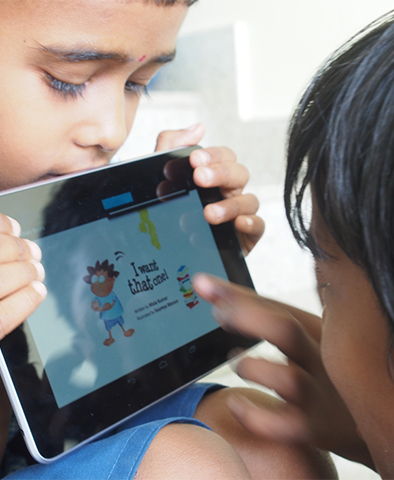
StoryWeaver, an initiative of Pratham Books, is among 12 finalists chosen by the World Innovation Summit for Education (WISE) for their innovative and impactful approaches to today’s most urgent education challenges
Each year, the WISE Awards recognize and promote innovative projects from around the world that are addressing global educational challenges.
StoryWeaver is an innovative digital platform which harnesses the power of technology, open licensing and collaboration to address the global scarcity of books for children in mother tongue languages. StoryWeaver also allows for content to be translated and versioned for localized needs. This responsive platform has published over 7500 story books available in 109 languages, making knowledge accessible to children and educators beyond global access barriers.
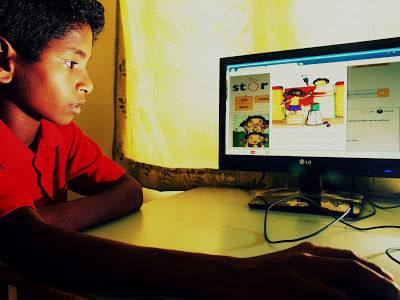
Suzanne Singh, Chairperson of Pratham Books, said StoryWeaver’svision is to massively scale the creation and distribution of reading resources for children in mother tongue languages. Our endeavor is to address the global scarcity of books for children and arm every child with the power of knowledge and opportunity. By providing access to thousands of storybooks, the platform has enabled educators to make classrooms more engaging, libraries more diverse and most importantly, make learning fun for children. With StoryWeaver, we have opened up a new pathway to nurture a generation of readers”.
Stavros N. Yiannouka, CEO of WISE, said: “We congratulate StoryWeaver for making it to the finalist stage. Each of the 2018 WISE Awards finalists has constructed an effective, tested solution to a global educational challenge. Whether it’s ensuring fundamental education for refugees or creating the next generation of empathetic and conscious leaders, each project is already transforming lives, and provides an inspirational model for others to adopt. This is vital to our mission at WISE, which centers around collaboration”.
The 12 projects come from eleven countries and were shortlisted for their innovative solutions to education challenges and their positive social impact. The awards finalists were picked from a pool of 413 projects, and evaluated according to strict criteria. They must be successful, innovative education projects that have already demonstrated a transformative impact on individuals, communities, and society. They must be financially stable, have a clear development plan and be scalable and replicable.
For further information, visit http://www.wise-qatar.org/wise- awards.
**********
About the WISE Awards:
Each year, the WISE Awards recognize and promote six successful innovative projects that are addressing global educational challenges. Since 2009, WISE has received more than 3,200 applications from over 150 countries. Up until now, 54 projects have won the WISE Awards, from a wide variety of sectors and locations for their innovative character, their positive contribution and their potential for scalability and adaptability. These projects represent a growing resource of expertise and sound educational practice. Year by year, WISE is building a community of educational innovators which offers a fertile environment for groundbreaking collaborations. Today the WISE Awards network comprises pioneering projects that are helping bring real change to societies and communities.
Be the first to comment.